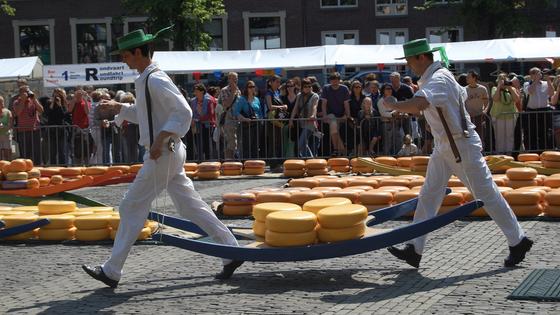Rick Steves’ Europe: A cheese-lover’s Europe
When I'm traveling, I become a cultural chameleon. I love a good pilsner in Prague, red wine in Tuscany, and a cheese course in France. For a cheese-lover, savoring Europe means savoring its cheeses – they're not only part of the cuisine, they're part of the culture. Here are just a few tips on how to see Europe as a tasty festival of mold.
France: In France, a love for beauty and tradition includes a fondness for artisan cheese that comes in wedges, cylinders, balls, and mini hockey pucks; and they're sometimes powdered white, gray or burnt marshmallow. Thankfully for the traveler, I find the cheese mongers of France to be evangelical about their fine and varied products.
Here, the cheese course is served just before (or instead of) dessert. It not only helps with digestion, it also gives you a great opportunity to sample the tasty regional cheeses – and time to finish up your wine. Between cow, goat, and sheep cheeses, there are more than 400 different varieties. Many restaurants offer a cheese platter, from which you choose a few. Whether at a restaurant or cheese shop, try at least four types: a hard cheese (such as Cantal), a flowery cheese (like Brie or Camembert), a blue or Roquefort cheese, and a goat cheese.
Be sure to go local. On your way to the châteaux in the Loire Valley, look for signs that say fromage de chèvres fermier (farmer's goat cheese). Or head to the Alps with a cheese map looking for les alpages, where you can taste hard, strong Beaufort or Gruyère-like Comté – and meet cheesemakers proud to show off their traditions.
Netherlands: The Dutch are probably better known for their cheese than for any other food, and are among the world's top cheese exporters. To sample their cheese culture, visit Alkmaar (and its Friday morning market from April-August) or Edam (Wednesday morning market in July and August). Both cities are a short train ride away from Amsterdam.
Alkmaar is Holland’s cheese capital (and, perhaps, the unofficial capital of high cholesterol). This delightful city has a zesty cheese-loving spirit and is home to what is probably the Netherlands’ best cheese museum...and in this country, that’s saying something. The museum is in Alkmaar's biggest building, the richly decorated Weigh House, used since the 16th century for weighing cheese.
Though Alkmaar is enjoyable any time, there’s no better time to sample a sliver of this proud wedge of Dutch culture than during market time. Early in the morning, cheesemakers line up their giant orange wheels in neat rows on the square. Prospective buyers (mostly wholesalers) examine and sample the cheeses and make their selections. Then the cheese is sold off with much fanfare, as an emcee narrates the action in Dutch and English.
During the Wednesday market in the cheesemaking village of Edam, farmers bring their cheese by boat and horse to the center of town, where it’s weighed and traded by Edamers in traditional garb. Edam cheese comes in softball-size rounds covered with red wax, so it travels well without refrigeration. Young Edam cheese is extremely mild, but it gets firmer and more flavorful with age.
Greece: Some studies show that Greece has the highest per-capita cheese consumption in the world – more than 60 pounds a year. That's mostly feta, which serves as one of the four "food groups" here, along with olives, tomatoes, and crispy phyllo dough. Protected by EU regulations, Greek feta is made with sheep’s milk, although a small percentage of goat’s milk can be added (but never cow’s milk). As you travel around Greece, you'll notice that feta in the Peloponnese is dryer and crumbly, while feta made in Macedonia is mild, soft, and creamy. Even in big-city Athens, you'll find markets that still sell feta from the barrel – and you'll also find feta in everything from salad and sandwiches to savory pies and dips. A Greek salad, topped with tasty vegetables and an enticing slab of feta cheese, is one Greek treat that never gets old.
Greeks don't live by feta alone. Graviera, a hard cheese made in Crete from sheep's milk, tastes sweet and nutty, almost like a fine Swiss cheese. And kasseri, a mild yellow cheese made from either sheep or goat's milk, is the most popular Greek cheese after feta.
I was raised thinking cheese was no big deal. It was orange and the shape of the bread … here’s your cheese sandwich. But while experiencing the cultural wonders of Europe, step out of your comfort zone — especially into the more expensive, more stinky cheeses — and you’ll be thankful you’ve appreciated Europe’s diverse and wonderful world of fine mold.
========
(Rick Steves (www.ricksteves.com) writes European guidebooks, hosts travel shows on public TV and radio, and organizes European tours. This column revisits some of Rick's favorite places over the past two decades. You can email Rick at rick@ricksteves.com and follow his blog on Facebook.)
©2025 Rick Steves. Distributed by Tribune Content Agency, LLC.
(c)2025 RICK STEVES DISTRIBUTED BY TRIBUNE MEDIA SERVICES, INC.














Comments